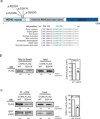COPA mutations impair ER-Golgi transport and cause hereditary autoimmune-mediated lung disease and arthritis
- PMID: 25894502
- PMCID: PMC4513663
- DOI: 10.1038/ng.3279
COPA mutations impair ER-Golgi transport and cause hereditary autoimmune-mediated lung disease and arthritis
Abstract
Unbiased genetic studies have uncovered surprising molecular mechanisms in human cellular immunity and autoimmunity. We performed whole-exome sequencing and targeted sequencing in five families with an apparent mendelian syndrome of autoimmunity characterized by high-titer autoantibodies, inflammatory arthritis and interstitial lung disease. We identified four unique deleterious variants in the COPA gene (encoding coatomer subunit α) affecting the same functional domain. Hypothesizing that mutant COPA leads to defective intracellular transport via coat protein complex I (COPI), we show that COPA variants impair binding to proteins targeted for retrograde Golgi-to-ER transport. Additionally, expression of mutant COPA results in ER stress and the upregulation of cytokines priming for a T helper type 17 (TH17) response. Patient-derived CD4(+) T cells also demonstrate significant skewing toward a TH17 phenotype that is implicated in autoimmunity. Our findings uncover an unexpected molecular link between a vesicular transport protein and a syndrome of autoimmunity manifested by lung and joint disease.
Figures




References
Publication types
MeSH terms
Substances
Grants and funding
- U54HG003273/HG/NHGRI NIH HHS/United States
- U54 HG006542/HG/NHGRI NIH HHS/United States
- R01 HL122533/HL/NHLBI NIH HHS/United States
- R01 AI067946/AI/NIAID NIH HHS/United States
- R37 AI067946/AI/NIAID NIH HHS/United States
- AI053831/AI/NIAID NIH HHS/United States
- K08 AR062064/AR/NIAMS NIH HHS/United States
- 2R01NS058529/NS/NINDS NIH HHS/United States
- K08HL095659/HL/NHLBI NIH HHS/United States
- R01 NS058529/NS/NINDS NIH HHS/United States
- R01 AI130197/AI/NIAID NIH HHS/United States
- K25 HL121295/HL/NHLBI NIH HHS/United States
- K23NS078056/NS/NINDS NIH HHS/United States
- K08 HL095659/HL/NHLBI NIH HHS/United States
- L30 HL098006/HL/NHLBI NIH HHS/United States
- R01AI067946/AI/NIAID NIH HHS/United States
- U54HG006542/HG/NHGRI NIH HHS/United States
- R21 AI129594/AI/NIAID NIH HHS/United States
- R21 AI124769/AI/NIAID NIH HHS/United States
- K23 NS078056/NS/NINDS NIH HHS/United States
- T32 AI053831/AI/NIAID NIH HHS/United States
LinkOut - more resources
Full Text Sources
Other Literature Sources
Medical
Molecular Biology Databases
Research Materials

